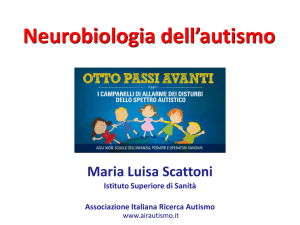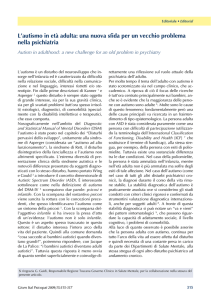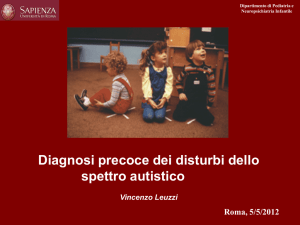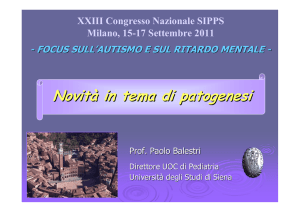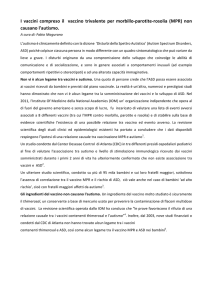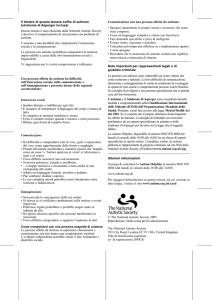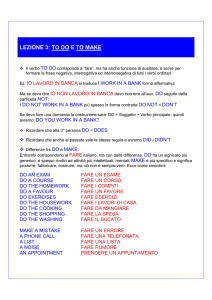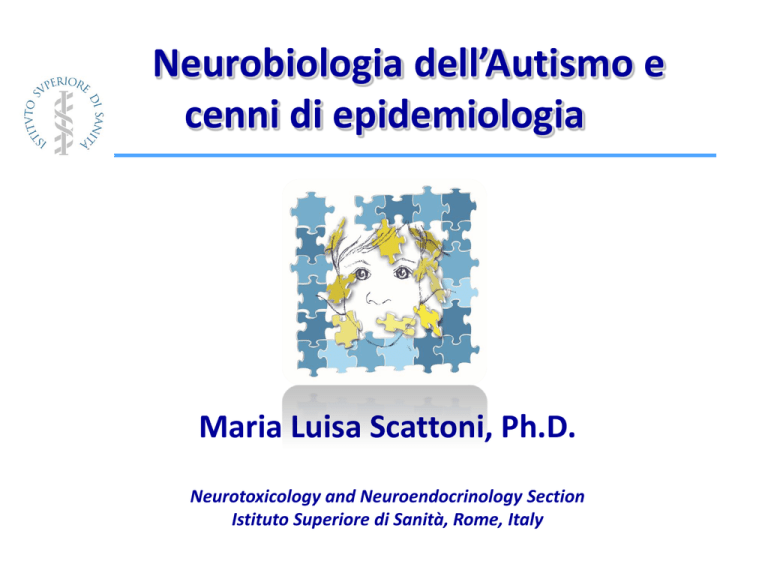
Neurobiologia dell’Autismo e
cenni di epidemiologia
Maria Luisa Scattoni, Ph.D.
Neurotoxicology and Neuroendocrinology Section
Istituto Superiore di Sanità, Rome, Italy
Special Issue November 2011
“I bambini del
nostro gruppo hanno
manifestato la loro profonda
solitudine dall’inizio della loro
vita, non rispondendo a niente
che provenisse dal
mondo esterno”
Leo Kanner,
Johns Hopkins University
Autistic disturbances of affective contact
Nervous Child 2:217-250, 1943
Un pò di storia…
1943: Leo Kanner
1952: Early-onset schizophrenia
1980: Infantile autism
1987: Autism Disorder
2000: Autism Spectrum Disorders: autism disorder,
Asperger’s syndrome, Rett Syndrome and pervasive
developmental disorder not otherwise specified’
(PDD-NOS)
Epidemiologia
CDC:
More than 90 in 10000
eight-year-olds in the
United States had autism
King, M. & Bearman P. P.Int J Epidemiol (2009); King M. & Bearman P. Am. Soc.Rev. (2011)
Epidemiologia
“Current US prevalence for autism is low because they don’t look at the entire
population. Many US studies are based on diagnosed cases of autism”,
Grinker, 2001
SOUTH KOREA: 1 in 38
In the 1980s, he had found Korean families generally unwilling to admit that
anything might be wrong with their children, because of the stigma attached.
But when he undertook the latest study, attitudes had changed. Families in
Ilsan, a stable, residential community on the outskirts of Seoul, welcomed
information about autism, which in this study was offered confidentially.
His team screened more than 55,000 children born between 1993 and 1999,
and came up with an estimated prevalence for ASD of 1 in 38.
Kim, Y. S. et al. Am. J. Psychiatry 168, 904–912 (2011)
Epidemiologia
Alcuni studi evidenziano come la prevalenza è sempre stata alta
1) Terry Brugha, a psychiatrist at the University of Leicester, UK
His team knocked on more than 7,000 doors across England: he calculated a prevalence
of autism in adults of 9.8 in 1,000 — close to the frequency found in US children.
Brugha, T. S. et al. Arch. Gen. Psychiatry 68, 459–465 (2011).
2) Christopher Gillberg, child and adolescent psychiatry at the University of Gothenburg
in Sweden
He found a prevalence of autism of 0.7% among seven-year-old Swedish children in
1983 and 1% in 1999.
Gillberg, C. J. Child Psychol. Psychiatry 24, 377–403 (1983).
Kadesjö, B., Gillberg, C. & Hagberg, B. J. Autism Dev. Disord. 29, 327–331 (1999).
Epidemiologia
Peter Bearman, a sociologist at Columbia University in New
York:
He analyzed nearly 5 million California birth records and
20,000 records from the state’s department of
developmental services
By linking birth with detailed diagnostic data he was able to
generate a rich picture of the demographics and life history
of those with autism, which yielded clues to the social factors
that influence diagnosis.
Epidemiologia
He still cannot explain 46% of the increase in autism:
new environmental pollutants?
King, M. & Bearman P. P.Int J Epidemiol (2009);
King M. & Bearman P. Am. Soc.Rev. (2011)
Environment?
During the past decade:
• the US federal goverment has spent
about:
-$1 billion researching the genetics of
autism
-$40 million on studies
environmental factors
of
possible
SEED
Under the auspices of CDC, began recruiting about 2700 children aged two to five
The study includes developmental evaluations, questionnaries, a review of medical
records and analysis of blood, cheek-cell and hair-samples to examine genetic makeup exposures to environmental chemicals
SEED
EARLI
Funded by NIH is enrolling up to 1200 families that have a child with autism and
are preparing to have another baby
The study intends to look for any interplay between environmental factors and
genetic susceptibility that might contribute to autism risk in their next child
Geni e ambiente
COMPONENTE
AMBIENTALE
DISTURBI DELLO
SPETTRO
AUTISTICO
ESPOSIZIONE IN UTERO A:
COMPONENTE
GENETICA
MICROARRAY
Virus della rosolia
Elevati livelli di testosterone
Sostanze che causano difetti
alla nascita: alcool etilico, acido
valproico (farmaco antiepilettico),
talidomide (farmaco tranquillante
ed antiematico)
Sono in studio gli organofosfati
(sostanze comunemente usate come
pesticidi in agricoltura e come
insetticidi in ambito domestico)
Copy number variations (CNVs)
(Delezione o duplicazione di piccoli
segmenti di DNA)
Mutazioni puntiformi (SNPs)
(Polimorfismo di un singolo
nucleotide)
Sintomi (DSM-IV)
deficit nelle
interazioni
sociali
modelli
stereotipati e
ripetitivi
nell’ambito di
comportamenti,
interessi e
attività
DISTURBI
DELLO
SPETTRO
AUTISTICO
deficit nel
linguaggio e nella
comunicazione
Causes of Autism Spectrum Disorders:
strongest evidence is genetic
4:1 frequency ratio boys:girls in ASD (8:1 in AS e 1:1 quando QI<50)
Concordance is 60-80% for monozygotic twins
Concordance is 20-30% in dizygotic twins
Linkage analyses indicate many genes underlying Autism Spectrum
Disorders, including linkages at chromosomal loci 15q11-q13,
16p11.2, 22q13, X-linked
Multiple putative candidate genes include GABA-β3, 5-HTT, MET,
PTEN, En2, UBE3a, CNTNAP2, neurexins, neuroligins, shanks, SYN-1
and genes for comorbid neurodevelopmental disorders including
FMR1, MECP2, TSC
High risk infants
Baby Siblings Research Consortium Study
finanziato da AUTISM SPEAKS
- 12 siti negli Stati Uniti
- 664 bambini ad alto rischio reclutati e seguiti fino
ai 36 mesi
- 132 bambini diagnosticati con DSA (41% autismo; 59%
con Disturbi generalizzati dello sviluppo non altrimenti
specificati)
RISCHIO SALITO AL 18% (25.9% nei maschi
e 9.6% nelle femmine)
La complessità della
genetica alla base
dei DSA
ASD candidates
Genes showing
association with ASD
ASD genes
Holt and Monaco, EMBO Mol Med. 2011
Mendelian Syndromes
12p13.33 (CACNA1C) Timothy Syndrome
15q11.2 (UBE3A) Angelman Syndrome
Xq27.3 (FMR1) Fragile X Syndrome
Xq28 (MECP2) Rett Syndrome
increase in risk for ASDs
Rare variants
2p16.3 (NRXN1) ASD, ID, language delay, SCZ
3p13 (FOXP1) ID, ASD
22q13.33 (SHANK3) ASD
Xp22.32-p22.31 (NLGN4X) ASD, ID, TS, ADHD
Xq13.1 (NLGN3) ASD
Common Alleles
1q42.2 (DISC1)
7q22.1 (RELN)
7q36.3 (EN2)
Geni della funzionalità sinaptica
Matthew W State & Pat Levitt, Nature, 2011
Analisi dei trascritti (trascrittomica)
Voineagu I et al. Nature, 1-5 (2011)
Dendritic spine pathology in
neuropsychiatric disorders
Penzes et al., Nat Neuroscience 2011
Dendritic spine pathology in ASD
Penzes et al., Nat Neuroscience 2011
Neuroni e spine dendritiche
Neurone di controllo:
proteine in equilibrio derivate da un
corretto livello di espressione
Sindrome dell’ X fragile:
Sindrome di Angelman:
normal dendrites but an
increased density of
longer, thinner, immatureappearing dendritic spines
normal dendrites but a decreased
density of, and abnormally
shaped, dendritic spines
Sindrome di Rett :
Sindrome di Rett :
(Mecp2-null mice)
decreased density of dendrites
and decreased density of,
and abnormally shaped, synapses
(represented by dendritic spines)
(Mecp2 is duplicated)
increased density of synapses
(represented by increased density of
dendrites and dendritic spines)
Melissa B. Ramocki & Huda Y. Zoghbi; Nature; 2011
Variazioni anche
nel numero di neuroni
Il peso del cervello è
maggiore nei
bambini autistici
Corteccia prefrontale:
n=7
n=6
tra i 2 e i 16 anni
Courchense E. et al, Jama, 2011
Variazioni anche
nel numero di neuroni
Nella corteccia prefrontale si osserva un
maggior numero di neuroni
Le cause dell’aumento di neuroni sono
da ricercare al livello prenatale
Courchense E. et al, Jama, 2011
Problemi di connettività
Neul JL, Nature 17 Nov 2011
Dosenbach, N.U. et al. Science 329, 1358–1361 (2010)
Problemi di connettività
Squilibrio eccitazione-inibizione
Yizhar O. et al. Nature, 1-8 (2011)
GABA
• in the mature brain GABA acts as an
inhibitory transmitter
• during the embryonic and the
perinatal period, this neurotransmitter
depolarizes targeted cells and triggers
calcium influx
REGOLA molti processi durante lo
sviluppo:
Proliferazione cellulare
Migrazione
Differenziamento
Maturazione sinaptica
Morte cellulare
X-fragile
Fmr1(fragile X mental retardation 1): sul braccio lungo
del cromosoma X (Xq27.3) codifica per la proteina FMRP
- mental retardation with language deficits,
- hyperactivity,
- autistic behavior
- seizures
the ‘mGluR theory of fragile X’
In assenza di FMRP:
- attivazione recettori mGluR5 (recettori metabotropici del
glutammato) conduce ad un’eccessiva sintesi di proteine
sinaptiche
- impairment of GABAergic circuitry and a decreased
expression of GABAA receptor subunits
Loss of GABAergic function = hyper excitability
Nonostante tutte queste osservazioni non esistono
dei marcatori precoci per l’autismo perchè:
• Il disturbo si sviluppa tra il periodo pre-natale e la prima adolescenza
quindi si possono sviluppare interazioni tra fattori di rischio multipli
• I pochi biomarcatori candidati non sono stati rilevati in tutti i pazienti
autistici
• Biomarcatori trovati sono spesso associati con altri disturbi del
neurosviluppo
Crescita cerebrale anomala:
Circonferenza cranica:
valore medio
normale
Courchesne, E. et al. JAMA 2003;290:337-344
Quali sono le aree cerebrali
coinvolte nell’autismo?
Amaral et al., Trends Neurosci. 2008
ISS and NIMH STRATEGY
for testing genetic hypotheses about the causes of autism
Candidate
Gene Mutant
Mouse
Therapeutic
Interventions
Clinical
Findings
With gratitude to
Geri Dawson, Uta Frith,
Cathy Lord, Sarah Spence,
Sue Swedo, Audrey Thurm
Biological
Mechanisms
Behavioral
Phenotyping
Developmental
Trajectory
Mouse Models with Mutations in Candidate Genes
Adapted from Abrahams and Geschwind, Nature Reviews Genetics 2008
Human Gene
Co-morbid Syndrome
AVPR1a
CACNA1C
Mutant
Mouse
Yes
Timothy
Yes
CADPS2
No
CNTNAP2
Yes
DHCR7
Smith-Lemli-Opitz
EN2
FMR1
Yes
Yes
Fragile X
Yes
GABARβ2
Yes
ITBG3
Yes
MECP2
Rett
Yes
MET
(tumors)
Yes
NRXN1
Yes
NLGN3
Yes
NLGN4
Yes
OXTR
Yes
PTEN
(cancers)
RELN
SHANK3
Yes
Yes
22q13 deletion Phelan-McDermid
SLC6A4
Yes
Yes
TSC1, TSc2
Tuberous sclerosis
Yes
UBE3A
Angelman
Yes
Why are Mouse Models Useful?
Mice and humans share 99% of their genes
Similar brain anatomy
Similar biochemistry, neurotransmitters, receptors
Similar physiology, brain electrophysiology
Analogous behavioral endophenotypes
Mice are a social species
Some social behaviors of
Mus musculus
nose-to-nose sniff
nose-to-anogenital sniff
fighting
social memory
nesting
parenting
mating
La famiglia dei geni SHANK
Autism is a
neurodevelopmental disorder
that is behaviorally defined
by three core symptoms:
Animal Models of Autism
Core Symptom #1
Sociability Deficit
Abnormal reciprocal social interactions, with deficits in eye gaze, joint attention, empathy
Uta Frith (2003) Autism: Understanding the Enigma
Sociability in Adult C57BL/6J (B6) Mice
Weighted
cup
prevents
climbing
Novel mouse
photobeam
motion
detectors
Center chamber
Start location
Empty wire cup
“Novel object”
“Normal”
mouse
“Autistic”
mouse
Sociability
WT
KO
Social Novelty
WT
KO
Core Symptom #2
Impairment in Social Communication
delayed onset and lower frequency of babbling, grunting, extended humming,
stereotypic squeals, or laughing inappropriately
Mice communicate primarily with
ultrasonic vocalizations
Proposed DSM-5 criteria:
two symptom criteria sets:
1) social communication and interaction
2) restricted, repetitive behavior
Adult Ultrasonic Vocalizations
C57BL/6J male mouse
Holy and Guo, PLoS Biology 2005
B6 male-female social interactions
BTBR male-female social interactions
Sociability deficit
WT
WT
KO
KO
WT
KO
Core Symptom #3
Stereotyped Repetitive Behaviors and
Narrow Restricted Interests
Videoscoring of spontaneous
jumping, grooming
stereotyped
Perseveration as a failure to make a change in a
search strategy, using Morris water maze and
T-maze spatial tasks
Restricted interests in a holeboard exploration
task
Self-Grooming
Densità sinaptica
SHANK3
Incorporate behavioral phenotypes for all 3
symptoms of autism
– Reduced sociability (social approach)
– Repetitive behaviors (greater self-grooming)
– Communication deficits (low number of ultrasonic
vocalizations during male-female interaction)
Modelli animali transgenici:
– Valutare la complessa interazione gene-ambiente
– Studiare i pathways neurobiologici alla base dei tre sintomi
principali dell’autismo
– Esplorare eventuali interventi terapeutici/comportamentali
Conclusioni
L’autismo è contraddistinto da una grande eterogeneità che rende
difficoltosa la validazione di teorie eziopatologiche capaci di sintetizzare gli
aspetti cognitivi, comportamentali e fisiologici.
Approssimativamente 67 milioni di persone nel mondo sono affette da
autismo, più di quante ne colpiscano i tumori, il diabete e l’AIDS messi
insieme.
Non esiste una cura per l’autismo ma la diagnosi e un intervento precoce ne
migliorano l’esito
la figura del PEDIATRA è indispensabile
Grazie per l’attenzione
“Non-invasive tools for early detection of
Autism Spectrum Disorders”
Ministero della Salute- Progetto Giovani Ricercatori 2008


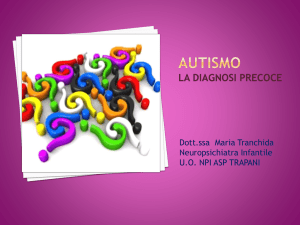
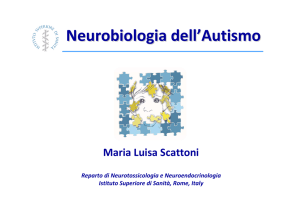
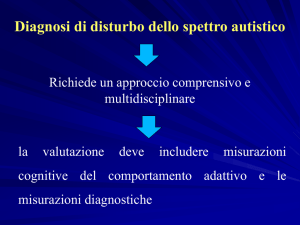
![Ppt0000018 [Sola lettura] - Istituto Superiore di Sanità](http://s1.studylibit.com/store/data/003262861_1-cc7add616317e8bcaebed11fb65c0ac2-300x300.png)
